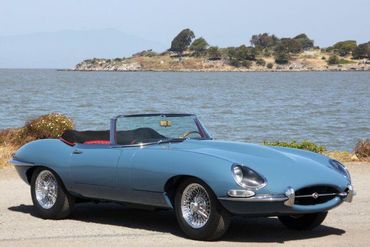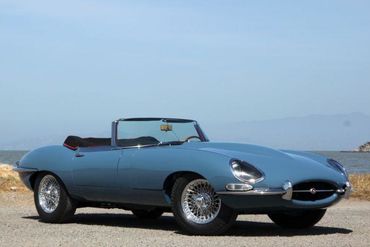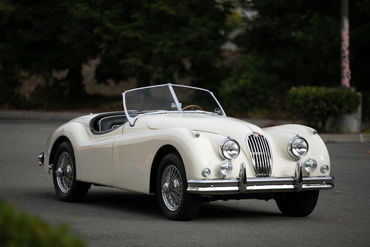Sold
SOLD 07/14
1967 Jaguar
E-Type Roadster
A Stunningly Restored E-Type Roadster, California Car from New with Interesting History
- VIN1E14519
- Exterior ColorCotswold Blue
- Interior ColorRed Leather
- Mileage72979 Miles
- Engine4.2 Litre Inline 6-Cylinder
- Engine no.7E11875-9
- Transmission4-Speed Manual
- StatusSold
- StockFJ1585
Description
1967 Jaguar E-Type Roadster
s/n 1E14519, engine no. 7E11875-9
Cotswold Blue with Red Leather Interior
The E-Type was unveiled in March of 1961 at the Geneva Motor Show, following the famous 11th hour disorder (one of the cars was driven to the show from England with just hours to spare). The car was an immediate sensation: its specification was state of the art, its bodywork arrestingly gorgeous, and the price surprisingly affordable. It embodied William Lyons' values beautifully and it is no surprise that the E-Type has become such a legendary part of automotive history. The specification clearly demonstrated Jaguar's racing experience and included independent suspension all around (at a time when Ferrari was still using live rear axles), disc brakes all around (inboard at the rear to reduce unsprung weight), and of course Jaguar's legendary twin cam inline-6.
As was common in period, the cars were continuously developed over their lives, both in terms of functional detail changes to items like fasteners and trim, and fairly significant mechanical improvements, culminating with the addition of 4.2 liter engine and fully synchronized gearboxes with lighter and more effective clutches for 1965. Later cars, starting in 1968, particularly in the United States, had safety and emissions equipment that negatively influenced both performance and aesthetics such as twin rather than triple carburetors and uncovered headlamps, so these Series I 4.2 liter cars, with their covered headlamps and triple carburetors, are widely considered to be the pick of the bunch. By 1967, the cars existed in their most fully developed form, with fitment of the power brake servo, higher capacity water pump, larger radiator, and numerous other technical detail improvements, in addition to a host of electrical improvements including alternator, solid state voltage regulator, and upgraded fuel system employing steel rather than plastic tubing, as well as an external fuel pump rated for higher flow and with self-adjusting fuel pressure.
This particular car was completed on the 10th of January 1967 and supplied new to the distributor Jaguar Cars in New York. Its first owner was Armstrong Harpman, an architect in Los Angeles, California who was at that time building a home for himself in the mountain community by the name of Pine Mountain. He eventually concluded that the E-Type was unsuitable for the rough and dusty roads, and in 1971 traded the car as partial payment to his General Contractor who was doing the work, James E. Peterson of Pasadena. Peterson was president of the California chapter of the Sports Car Club of America and was an avid racer. He raced an XK120 and was successful enough that he was hired by Mickey Thompson’s factory Corvette team and also Wacky Arnolt to drive Arnolt-Bristols in the 1956 12 hours of Sebring.
James Peterson built first condo project in California, a large development on the slopes of Laguna Beach. He was also the general contractor who designed and built Riverside Raceway and he collaborated with his architect, William L. Duquette to design the memorable track layout there. Peterson was friends with Carroll Shelby and a young Bob Bondurant, who actually drove a dump truck for Peterson’s company and also rented one of his properties. During this period, he had a Jaguar XKSS as his daily driver, which he purchased new. One of 16 built, that car is the now-famous Steve McQueen XKSS which is now part of the Peterson Automotive Museum (no relation). Peterson sold the car, which was originally cream with red interior (McQueen repainted it British Racing Green), to Bill Layden, a TV talk show host, who in turn sold it to Steve McQueen. A photo is included of the XKSS with Peterson and Layden (the car’s first and second owners), as well as actor and film director Cornel Wilde.
When Peterson died, the car was passed on to his daughter, who reportedly was babysat by Carroll Shelby as a child. She kept the car for some time before eventually selling it to its current owners in 2013, who embarked on a spectacular no-expense spared restoration to bring the car to its current condition.
The restoration was performed by Dave Ferguson of Images Auto Body in Campbell, CA to his famously high standards and the result is stunning. He reports having restored over 2000 E-Types over his 40 years in the business, and says that prior to the restoration, this was the finest examples he had seen in 20 years in terms of soundness, originality, and correctness. In fact, offered the car’s new owner for three times what he had just paid for it, an offer that was declined.
Mr. Ferguson observes that a great many restoration candidates are represented as rust-free California cars, this car actually was such a car, and that it was an exceptionally original and correct example with no accident damage or previous restoration work. No sheetmetal was replaced during the restoration, and all panels are original to the car. The original undercoating was still present on the floor, no jack marks were found in the floor, and no surface rust or flange rust was even found. Ferguson was given free rein to restore the car with no detail or expense spared, and the shop crew was instructed to do the car as though it would be their own personal car.
The car received a rotisserie restoration to the highest standards. The body was completely stripped and refinished, all interior sheetmetal stripped and powder coated or repainted as required, and the leather renewed with correct grain leather. A new mohair top was fitted and the chrome stripped and triple plated. All wiring was replaced down to the ground pigtails, with British wiring with PVC insulation, which is correct for a late Series I E-Type (earlier E-Types had canvas insultation). Many intelligent and tasteful upgrades where made during the restoration process which enhance the usability, performance, and reliability, without compromising the investment potential or visual presentation of the finished product. The rear brake cylinders were resleeved with new pads The suspension was replaced with polyurethane bushings. New upper and lower ball joints were fitted, as were new tie rod ends inner and outer with gators. The steering rack was rebuilt with new bushings, bearing seals, gators, bend tabs, and u-joints. An electronic ignition was used for ease of starting, assisted by a new coil. The engine was completely disassembled along with the transmission, and all of the rear suspension parts were powder coated along with the top frame. The differential was rebuilt by Rear End Specialties in San Jose, California using upgraded gears, and posi-traction bearings, clutches, and seals. The drive lines were spun balanced with new U joints in both of the half shafts and driveshaft. Dynomat was used in the entire interior including inside the doors to ensure a solid sounding door closure. The restorer upgraded the cooling fan to a 10 blade fan, and the electric cooling fan motor to a higher efficiency one which is easily reversed to go to a show for points if desired. The restorer comments that “engine cooling was the most important factor”. Thus far, several hundred miles have been logged to ensure sorting and proper function of all mechanical items.
The restoration was completed in 2014 and the car is in exceptional, freshly restored condition. The paintwork, chrome, and all other cosmetic aspects of the exterior of the car were renewed and are like new. The paint color of Cotswold Blue is an original Jaguar color, and was available as an option for this year. The body is very straight and displays great fit and the paintwork was performed to high standards. The glass and lights were replaced as were the rubber and seals.
The interior was also comprehensively and correctly restored. Correct materials and finishes were used throughout, including the upholstery on the doors, sills, seats, dashboard, and the carpets. All materials were matched to original Jaguar specifications by OSJI and BAS interiors. The carpets and all upholstery were replaced, and the dashboard restored as well. The instruments and switches are like new other than the headlight switch surround which has crazing, and some blemishes in the chrome on the heater air distribution slider surround. The correct rubber Jaguar mats are in place and the car is free of even the minor modifications these cars sometimes have such as aftermarket radio or shift knob. The top is new and its frame was restored, and the car has a black canvas top boot with red edging to match the upholstery.
The engine compartment is extremely clean and correct in appearance, and spotlessly detailed in a way that only a car that has been fully disassembled can be. The correct finishes and ancillaries are in place throughout. The cylinder head is unstamped while the block matches the chassis plate and heritage certificate. The trunk was comprehensively restored as well, including beneath the floor and in the spare tire well. The undercarriage is stunningly clean and has been restored to the same high standards of the remainder of the car. It is genuinely cleaner than the top of most cars.
In addition to the car’s fantastic cosmetic presentation, this E-Type drives well too. Many restored cars are not fully resolved from a driving experience perspective, and this car is a pleasing exception to that. The engine runs well with great oil pressure and good power delivery, the steering is tight and direct, the transmission and clutch operate well, and the chassis is coherent and free of issues in operation. The instruments work, and the top is easy to operate and fits well.
It is hard to overstate the significance of the E-Type. Evocative of the swinging 60s like few other cars, the E-Type was a surprisingly accessible car, and quite a few were built. They appeared in many movies and were owned by a variety of famous personalities, and it was the first car to ever appear in the Museum of Modern Art. It was also famously described by Enzo Ferrari as the most beautiful car in the world.
This particular example is surely one of the most beautiful examples in the world of what is agreed to be one of the most beautiful cars ever. Furthermore, it has distinguished and fascinating history, ensuring that it will appeal to the buyer seeking the very best. A California car from new, this car has exceptionally distinguished history and has always been a structurally exemplary and undisturbed example. The restoration of the car was executed to fantastic standards and included every aspect of the car. It was performed by an experienced marque specialist and would perform well if shown. It comes with a thick file of invoices from the restoration, Jaguar Daimler Heritage Trust Certificate, as well as its original jack, tools, and books set. The Heritage Certificate indicates that the engine block matches the chassis, as well as the car’s original owner and color combination of Valentine Beige with Tan Interior.
The above vehicle information is complete and accurate to the best of our knowledge at the time it is posted to this website. Corrections or additional information is always appreciated. All advertised prices exclude government fees and taxes, any finance charges, any dealer document preparation charge, and any emission testing charge. Vehicles are subject to prior sale. All advertised to be true but not guaranteed. We assume no liability for errors or omissions.
Inquire About This Car
Fantasy Junction • 510-653-7555 • 1145 Park Ave, Emeryville, CA 94608





